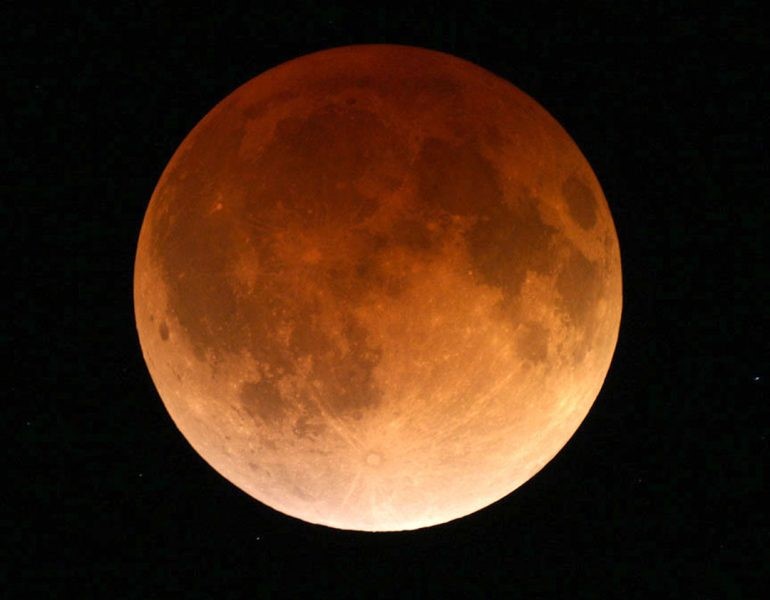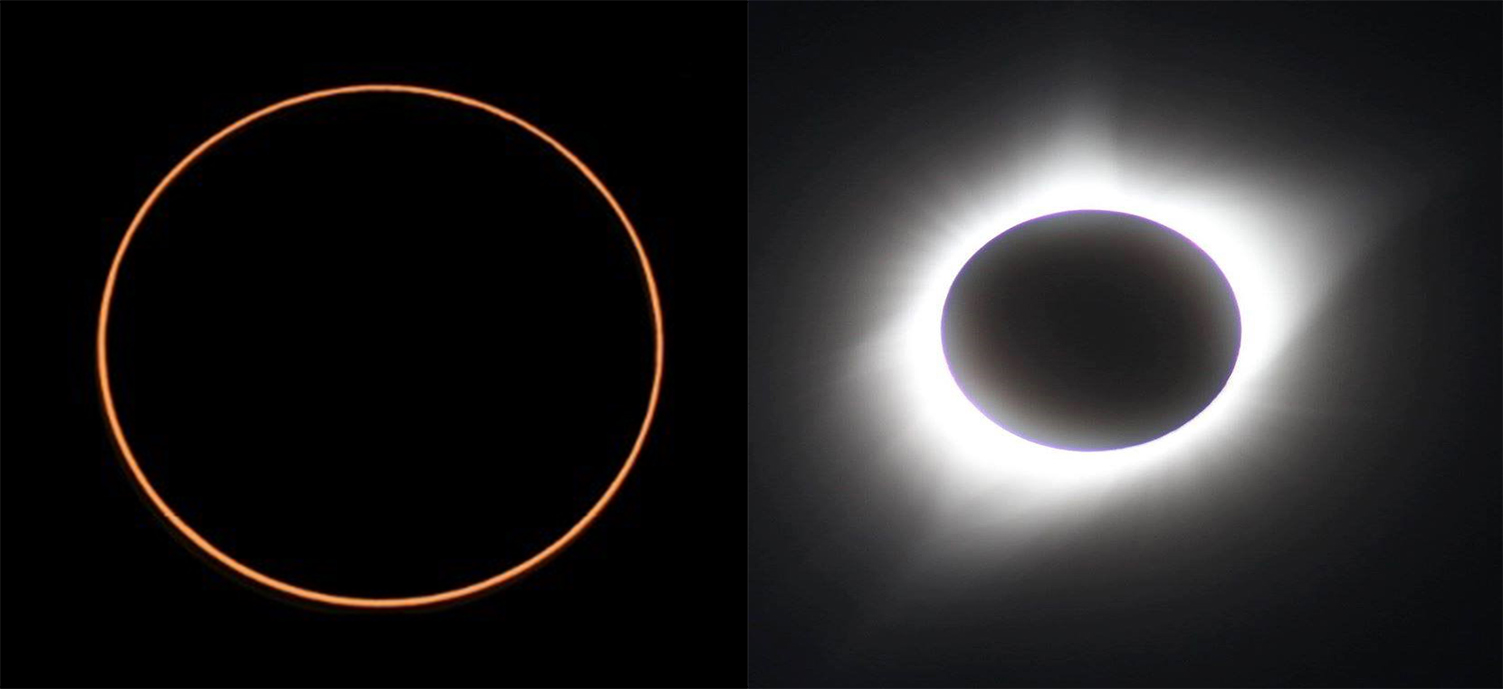ECLIPSED!?
Our Sun, Moon, and the Earth all lie nearly, but not quite exactly in the same plane in space. Most months, when the Moon passes between the Earth and Sun, it passes just above or below the plane, and there is no eclipse of the Sun. Likewise, when the Earth passes between the Moon and Sun and casts its shadow, it usually misses the Moon. However, twice a month, the Moon in its orbit around the Earth passes through a node, a point where it passes through the plane. If the Moon passes through the node while at the same time most nearly in line with Earth and Sun, there can be an eclipse. These can be partial or total eclipses, depending upon how perfect the alignment is, and how close the Moon is to the Earth at the time of the event. During the rest of 2021, there are no fewer than three eclipses of some kind that are visible from at least part of the United States, but frustratingly, all of them are either invisible or badly timed as seen from St. Louis.
At the time of this writing, it is just a few days until the Total Eclipse of the Moon occurs, on May 26. The Earth passes between Moon and Sun and casts its shadow on the Moon. Some sunlight filters through Earth’s atmosphere and around the Earth and faintly lighting up the Moon. This causes the Moon to usually shine a reddish orange color that is often called a “Blood Moon” by the media. Depending upon the overall clarity of Earth’s atmosphere, including recent volcanic eruptions, the Blood Moon can look quite bright or very dim, much like a new or very tarnished penny. This uncertainty makes observing total lunar eclipses a lot of fun, since you never can be sure exactly what they will look like. On May 26, the Moon will not just be full but will also be near its closest point, or perigee. It thus will look about 8% larger than average- hardly dramatic, but the media has named this circumstance the “supermoon.” In addition, each Full Moon has a given name by various cultures, and that of May is often called the “Flower Moon.” You may have noticed that some media sources have been calling the May 26 eclipse the “Super Flower Blood Moon.”

A Sky & Telescope image of the “blood moon” of 2014. Unfortunately, as seen from St. Louis, the Moon will set before the May 26 eclipse becomes total. Some sunlight filters around the Earth and faintly illuminates the Moon, which is deep in Earth’s shadow.
I have seen many total eclipses of the Moon and they are quite cool and perfectly safe to look at. The Full Moon, although very bright, is much dimmer than the Sun, and then is dimmed further by an eclipse. To me, “blood moons” are major events, but there is no “darkness at noon” or dramatic cooling, and no beautiful, extremely rarely seen corona appears like there is in a total eclipse of the Sun. While solar totality is visible from a rather narrow band, the total lunar eclipse can be seen anywhere that the Moon is above the horizon. This is where the problem is for the May 26 event, as seen from St. Louis. A full moon, being opposite the Sun in the sky, rises around sunset and sets near sunrise. The Moon does not enter the umbra, or main part of the Earth’s shadow, until about 4:45 AM in St. Louis, although a slight penumbral shading might be noticed up to 15-30 minutes before this time. Dawn will already be beginning at the time of the beginning of the partial stages, and the Moon will already be quite low in the sky and will only drop lower. You will need an open view to the western horizon to see anything of this eclipse, and the Moon will probably fade into the hazy air near the horizon well before its actual setting time of about 5:44 am. A short total eclipse of the moon will begin at 6:11 am, but the Moon will be long gone as seen from around here. Despite this depressing result, I plan to be out there watching the partial stages, and if you are an early riser, you can too. If skies are clear and you have an open view, you will see a progressively larger “bite” taken out of the Moon, until it gets too low.
Two weeks later, on June 10, there is an even more infuriating result. It is the Moon’s turn to pass between the Earth and Sun. The line up is perfect except for one thing. Since the Moon takes about four weeks to orbit Earth and the lunar eclipse occurred at perigee two weeks earlier, Luna looks its smallest on June 10, not large enough to cover the entire Sun. Thus a thin ring of sunlight will surround the black Moon, silhouetted against the Sun. Since the geometry behind these annular eclipses is so unusual, they are rare and definitely worth a look, but the brilliance of the ring prevents the beautiful corona of the Sun from being visible. Solar filters must be used at all times due to the brilliance of the remaining vestige of sunlight. Perhaps some of my readers can remember the annular eclipse on May 10, 1994, which was visible from St. Louis.

LEFT: Sky & Telescope image of an annular eclipse of the Sun, February 2021. An annular eclipse was seen in St. Louis in 1994, but little or none of the June 10 eclipse will be seen here. RIGHT: Image of the total solar eclipse of August 21, 2017, taken by our Sky Ranger in Moneta, Wyoming. In both types of eclipses, the Moon lies directly between the Earth and Sun. In an annular eclipse, the Moon is farther away and does not appear large enough to cover the entire Sun, leaving a ring of light around it. In a total solar eclipse, the Moon appears just barely large enough to cover the whole disk, but not the beautiful corona.
Unfortunately, the June 10 eclipse is not really visible from the St. Louis area. The “ring of fire” takes place well before sunrise here and is seen only from north of Lake Superior in Canada as well as parts of Greenland and Russia. Even the partial stages are missed, as the sun rises at 5:36 am, exactly as the last bit of the Moon appears to move off the Sun’s disk. Possibly the slightest trace of the eclipse might be very briefly visible at sunrise from St. Louis’ far eastern suburbs- more likely from Springfield, Illinois or Chicago. Bring your solar filters, or more realistically, better luck next time.
After these two unfortunate results, the situation starts to improve with the partial lunar eclipse on November 19, although it will still take place at an inconvenient time for most people. The moon will begin to enter Earth’s dark umbral shadow at 1:18 am, and the eclipse will be 97% total at 3:02 am before leaving the umbra at 4:47 am. This will be a good event if you can brave the cool temperatures and early morning hours and may be close enough to total that some of the “blood moon” effect will be noticeable.
The situation for 2022 is even better. Two total eclipses of the Moon will be visible here, on May 15 and November 8, with the May event taking place in evening hours. 2023 will feature a large partial eclipse of the Sun, visible from St. Louis, with the eclipse annular from parts of the west and Texas. And 2024 will feature the Next Big One on April 8. This solar eclipse will be nearly total in St. Louis, and a drive of as little as thirty miles can take you into dramatic, extremely rare darkness. I have been lucky enough and have traveled enough to witness four total solar eclipses in five attempts and will attempt to make it five out of six then.
Catch our next Gateway to the Stars program at 8 pm on June 19. This virtual online program will feature local astronomer and former “Dark Ranger” Joel Allen discuss “The Lives of Stars.” This will be followed by “Virtual Stargazing at the Gateway Arch,” including a tour of June’s night sky by our Sky Ranger and live or recorded images of celestial objects, submitted by volunteers from the St. Louis Astronomical Society. The program will be streamed via Facebook Live at www.facebook.com/stlastro.
